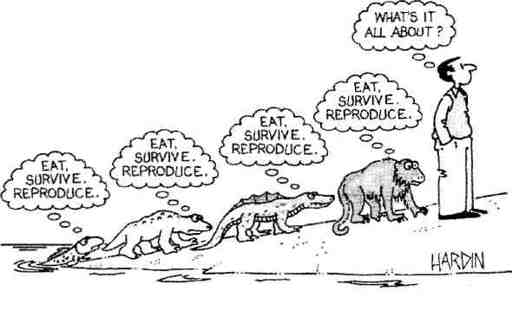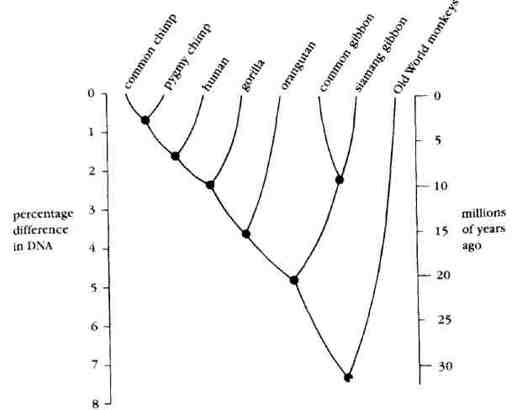Darwin's Dangerous Idea (63 page)
Read Darwin's Dangerous Idea Online
Authors: Daniel C. Dennett

beneficiaries of all the selective forces on the planet. That is to say, there We are different. There is a huge scope for alternative policies in human were no forces whose
principal
beneficiary was anything else. There were life, but the question then becomes: how and when does this scope get
accidents
and
catastrophes
(lightning bolts and tidal waves), but no
steady
established? There can be no doubt that many people have clearheadedly, forces acting systematically to favor anything but genes.
well-informedly
chosen
to forgo the risks and pains of childbearing for the safety and comfort of a "barren" life of other rewards. The culture may stack

330 CONTROVERSIES CONTAINED
CuiBono?
331
CHAPTER 11:
Panspermia, intergalactic gene-splicers, and multiple origins of
life on Earth are all harmless if unwelcome heretical possibilities. Teilhard's
"Omega-point," Lamarck's genetic transmission of acquired traits, and directed mutation (without a crane to support it) would be fatal to Darwinism,
but are safely discredited. The controversies over the units of selection and
the "genc's-eye point of view" are important issues in contemporary evolutionary theory, but they don't have the dire implications often seen in them,
whichever way they come out.
This completes our survey of Darwinism in biology itself. Now that we are
armed with a fair and quite detailed picture of contemporary Darwinism, we
ore ready to see, in part III, what implications it has for
Homo sapiens.
CHAPTER 12:
The primary difference between our species and all others is
our reliance on cultural transmission of information, and hence on cultural
evolution. The unit of cultural evolution, Dawkins'
meme,
has a powerful and
underappreciated role to play in our analysis of the human sphere.
FIGURE 11.1
the deck against it (with such loaded words as "barren" ), and it is true that it is a reversal of the fundamental strategy of all life, but, still, it often happens.
We
recognize that bearing and raising offspring is just one of life's possible projects, and by no means the most important, given
our
values. But where could those values have come from? How did our control systems become equipped with them, if not by miraculous surgery? How is it that we have been able to establish a rival perspective that can often overpower our genes'
interests while other species have not?8 This will be a topic for the next chapter.
8. Dog-lovers may protest that there is good evidence of dogs' sacrificing their lives for their human masters, putting their own prospects for reproduction and even "personal"
longevity firmly in second place. Certainly this can happen, because dogs have actually been
bred
for this very capacity to acquire such occasionally fatal trans-species loyalties.
These are necessarily exceptional cases, however. The cartoonist Al Capp saw the problem many years ago when he created his delightful shmoos, white armless blobs with two rather pseudopodal feet and happy, cat-whiskered faces. Shmoos loved people above all, and instantly sacrificed themselves whenever appropriate, turning themselves into sumptuous roast beef dinners (or peanut-butter sandwiches, or whatever their human companions happened to need or desire). Shmoos, you may recall, reproduced asexually by cloning in large numbers at the drop of a hat—a bit of poetic license that got Capp out of the nagging problem of how shmoos, given their proclivities, could ever have survived.
Kim Sterelny has suggested to me that shmoos exhibit the sort of features we should look for as proof of intergalactic interlopers in our past! If we found organisms whose adaptations were manifestly not for their own direct benefit, but for the benefit of their putative makers, this would properly set us wondering, but it would not be conclusive.
PART III
MIND, MEANING,
MATHEMATICS, AND
MORALITY
The new fundamental feeling: our conclusive transitoriness.—
Formerly
one sought the feeling of the grandeur of man by pointing to his divine
origin,
this has now become a forbidden way, for at its portal stands the
ape, together with other gruesome beasts, grinning knowingly as if to
say: no further in this direction! One therefore now tries the opposite
direction: the way mankind is
going
shall serve as proof of his grandeur
and kinship with God. Alas this, too, is vain! At the end of this way
stands the funeral urn of the
last man
and gravedigger (with the inscription
'nihil humani a me alienum puto
'). However high mankind may
have evolved
—and
perhaps at the end it will stand even lower than at
the beginning!
—
it cannot pass over into a higher order, as little as the
ant and the earwig can at the end of its 'earthly course' rise up to
kinship with God and eternal life. The becoming drags the has-been
along behind it: why should an exception to this eternal spectacle be
made on behalf of some little star or for any little species upon it! Away
with such sentimentalities!
—FRIEDRICH NIETZSCHE 1881, p. 47
CHAPTER TWELVE
The Cranes of Culture
1. THE MONKEY'S UNCLE MEETS THE MEME
What is the question now placed before society with a glib assurance
the most astounding? The question is this
—
Is man an ape or an angel?
My Lord, I am on the side of the angels.
—BENJAMIN DISRAELI, speech at Oxford, 1864
Darwin himself saw clearly that if he claimed that his theory applied to one particular species, this would upset its members in ways he dreaded, so he held back at first. There is almost no mention of our species in
Origin of
Species
—aside from its important role as a crane in artificial selection. But of course this fooled no one. It was clear where the theory was heading, so Darwin worked hard to produce his own, carefully thought-out version before the critics and skeptics could bury the issue in misrepresentations and alarm calls:
The Descent of Man, and Selection in Relation to Sex
(1871). There was no doubt at all, Darwin observed: we—
Homo sapiens
— are one of the species over which evolutionary theory reigns. Seeing that there was little hope of denying this fact, some Darwin-dreaders have sought a champion who might deliver a pre-emptive strike, disabling the dangerous idea before it ever got a chance to spread across the isthmus that connects our species with all the others. Whenever they have found someone announcing the demise of Darwinism (or neo-Darwinism, or the modern synthesis), they have egged him on, hoping that this time the revolution would be real. Self-styled revolutionaries have struck early and often, but, as we have seen, they have managed only to invigorate their target, deepening our understanding of it while enhancing it with complexities undreamt of by Darwin himself.
Falling back, then, some of the foes of Darwin's dangerous idea have planted themselves firmly on the isthmus, like Horatio at the bridge, intent

336 THE CRANES OF CULTURE
The Monkey's Uncle Meets the Meme
337
on preventing the idea from crossing over. The famous first confrontation was the notorious debate in Oxford's Museum of Natural History in 1860, only a few months after the initial publication of
Origin,
between "Soapy Sam" Wilberforce, Bishop of Oxford, and Thomas Henry Huxley, "Darwin's bulldog." This is a tale told so often in so many variations that we might count it a phylum of memes, not just a species. Here it was that the good bishop made his famous rhetorical mistake, asking Huxley whether it was on his grandfather's side or his grandmother's side that he was descended from an ape. Tempers were running high in that meeting room; a woman had fainted, and several of Darwin's supporters were almost beside themselves with fury at the contemptuous misrepresentation of their hero's theory that was being given, so it is understandable that eyewitnesses' stories diverge at this point. In the best version—which in all likelihood has undergone some significant design improvement over the retellings—Huxley replied that he
"was not ashamed to have a monkey for his ancestor; but he would be ashamed to be connected with a man who used great gifts to obscure the truth" (R. Richards 1987, p. 4; see also pp. 549-51, and Desmond and Moore 1991, ch. 33).
And ever since, some members of
Homo sapiens
have been remarkably thin-skinned about our ancestral relationship to the apes. When Jared Diamond published
The Third Chimpanzee
in 1992, he drew his title from the recently discovered fact that we human beings are actually more closely related to the two species of chimpanzees
{Pan troglodytes,
the familiar Family tree of the higher primates. Trace back each pair of modern higher primates chimp, and
Pan paniscus,
the rare, smaller pygmy chimp or bonobo ) than to the black dot connecting them. The numbers to the left then give the percentage those chimpanzees are to the other apes. We three species have a common difference between the DNAs of those modern primates, while the numbers to the ancestor more recent than the common ancestor of the chimpanzee and the right give the estimated number of millions of years ago since they last shared a gorilla, for instance, so we are all on one branch of the Tree of Life, with common ancestor. For example, the common and pygmy chimps differ in about 0.7
gorillas and orangutans and everything else on other branches.
percent of the DNA and diverged around three million years ago; we differ in 1.6
We are the third chimpanzee. Diamond cautiously lifted this fascinating percent of our DNA from either chimp and diverged from their common ancestor around seven million years ago, and gorillas differ in about 2.3 percent of their DNA fact from the "philological" work on primate DNA by Sibley and Ahlquist from us or chimps and diverged from the common ancestor leading to us and the (1984 and later papers), and made it clear to his readers that theirs were a two chimps around ten million years ago. [Diamond 1992]
somewhat controversial set of studies ( Diamond 1992, pp. 20, 371-72). He FIGURE 12.1
was not cautious enough for one reviewer, however. Jonathan Marks, an anthropologist at Yale, went into orbit in denunciation of Diamond—and more powerful techniques). Why, though, should it make any
moral
dif-Sibley and Ahlquist, whose work, he declared, "needs to be treated like ference whether we or the gorillas win the competition to be the closest nuclear waste: bury it safely and forget about it for a million years" (Marks cousin of the chimpanzee? The apes are our closest kin in any case. But it 1993a, p. 61). Since 1988, Marks, whose own earlier investigations of pri-matters mightily to Marks, apparently, whose desire to discredit Sibley and mate chromosomes had placed the chimpanzee
marginally
closer to the Ahlquist has driven him right out of bounds. His most recent attack on them, gorilla than to us, has waged a startlingly vituperative campaign condemning in a review of some other books in
American Scientist
( Marks 1993b), drew Sibley and Ahlquist, but this campaign has recently suffered a major setback.
a chorus of condemnation from his fellow scientists, and a remarkable apol-The original findings of Sibley and Ahlquist have been roundly confirmed by ogy from the editors of that magazine: "Although reviewers' opinions are more sensitive methods of analysis (theirs was a relatively crude technique, their own and not the magazine's, the editors do set standards that we deeply path-finding at the time, but subsequently superseded by regret were not maintained in the review in question" (Sept.-Oct.
338 THE CRANES OF CULTURE
The Monkey's Uncle Meets the Meme
339
1993, p. 407). Like Bishop Wilberforce before him, Jonathan Marks got never forget that there is no inertia at all in selection pressure. Pressures that carried away.